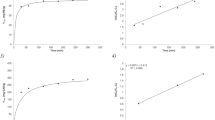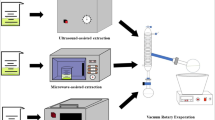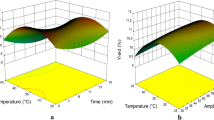Abstract
The extraction of concentrated volatile oils from various plant species is generally carried out by hydrodistillation technique. However, this hydrodistillation technique is expensive owing to more solvent and energy consumption. In this study, effect of ultrasonic pre-treatment prior to hydrodistillation on extraction of Cinnamomum cassia bark oil was evaluated. Process variables for extraction were optimized by Taguchi method. Results revealed that ultrasound pre-treatment hydrodistillation (UAHD) can enhance the yield of the extracted oil when compared with conventional hydrodistillation (HD) technique. To predict the yield of the extracted essential oil significant mathematical model was developed. Optimum parameters were determined according to the mathematical model they were: solid loading 25 g, ultrasound power 600 W, extraction time 35 min, and solvent quantity 100 ml. Further, gas chromatography–mass spectrometry (GC–MS) results of C. cassia bark oil revealed that UAHD produced more oxygenated compounds than HD extraction method. In addition, UAHD was found to be less energy consuming and environmentally safer than HD extraction method. Moreover, FT-IR spectra indicate that the effect of UAHD extraction method released all the volatile compounds from treated C. cassia bark powder. Finally, the optimum parameters were confirmed by the experiments performed, in which the yield of the oil of 3.17% was obtained. This study demonstrated that ultrasound pre-treatment prior to hydrodistillation could be useful to extract bioactive compounds with reduction in extraction time for extraction of C. cassia bark oil.
Graphic Abstract








Similar content being viewed by others
References
Mead, P.S., et al.: Food-related illness and death in the United States. Emerg. Infect. Dis. 5(5), 607 (1999)
Walker, S.: Major spoilage micro-organisms in milk and dairy products. Int. J. Dairy Technol. 41(4), 91–92 (1988)
Brewer, M.S., Sprouls, G.K., Russon, C.: Consumer attitudes toward food safety issues. J. Food Saf. 14(1), 63–76 (1994)
Bousbia, N., et al.: Comparison of two isolation methods for essential oil from rosemary leaves: hydrodistillation and microwave hydrodiffusion and gravity. Food Chem. 114(1), 355–362 (2009)
Geng, S., et al.: Variations in essential oil yield and composition during Cinnamomum cassia bark growth. Ind. Crops Prod. 33(1), 248–252 (2011)
Shan, B., et al.: Antibacterial properties and major bioactive components of cinnamon stick (Cinnamomum burmannii): activity against foodborne pathogenic bacteria. J. Agric. Food Chem. 55(14), 5484–5490 (2007)
Wang, R., Wang, R., Yang, B.: Extraction of essential oils from five cinnamon leaves and identification of their volatile compound compositions. Innov. Food Sci. Emerg. Technol. 10(2), 289–292 (2009)
Choi, J., et al.: Constituents of the essential oil of theCinnamomum cassia stem bark and the Biological Properties. Arch. Pharmacal Res. 24(5), 418–423 (2001)
Li, Y.-Q., Kong, D.-X., Wu, H.: Analysis and evaluation of essential oil components of cinnamon barks using GC–MS and FTIR spectroscopy. Ind. Crops Prod. 41, 269–278 (2013)
Chang, S.-T., Chen, P.-F., Chang, S.-C.: Antibacterial activity of leaf essential oils and their constituents from Cinnamomum osmophloeum. J. Ethnopharmacol. 77(1), 123–127 (2001)
Chao, L.K., et al.: Study on the antiinflammatory activity of essential oil from leaves of Cinnamomum osmophloeum. J. Agric. Food Chem. 53(18), 7274–7278 (2005)
Mancini-Filho, J., et al.: Antioxidant activity of cinnamon (Cinnamomum Zeylanicum, Breyne) extracts. Boll. Chim. Farm. 137(11), 443–447 (1998)
Murcia, M.A., et al.: Antioxidant evaluation in dessert spices compared with common food additives. Influence of irradiation procedure. J. Agric. Food Chem. 52(7), 1872–1881 (2004)
Schoene, N.W., et al.: Water-soluble polymeric polyphenols from cinnamon inhibit proliferation and alter cell cycle distribution patterns of hematologic tumor cell lines. Cancer Lett. 230(1), 134–140 (2005)
Shan, B., et al.: Stimulating activity of Chinese medicinal herbs on human lymphocytes in vitro. Int. J. Immunopharmacol. 21(3), 149–159 (1999)
Ding, Y., et al.: Discrimination of cinnamon bark and cinnamon twig samples sourced from various countries using HPLC-based fingerprint analysis. Food Chem. 127(2), 755–760 (2011)
Li, Y.-Q., et al.: Variations in essential oil yields and compositions of Cinnamomum cassia leaves at different developmental stages. Ind. Crops Prod. 47, 92–101 (2013)
Djouahri, A., Boudarene, L., Meklati, B.Y.: Effect of extraction method on chemical composition, antioxidant and anti-inflammatory activities of essential oil from the leaves of Algerian Tetraclinis articulata (Vahl) Masters. Ind. Crops Prod. 44, 32–36 (2013)
Gavahian, M., et al.: Comparison of ohmic-assisted hydrodistillation with traditional hydrodistillation for the extraction of essential oils from Thymus vulgaris L. Innov. Food Sci. Emerg. Technol. 14, 85–91 (2012)
Lo Presti, M., et al.: A comparison between different techniques for the isolation of rosemary essential oil. J. Sep. Sci. 28(3), 273–280 (2005)
Figueiredo, A., et al.: Physiological aspects of essential oil production, pp. 95–107. Basic and applied research, Essential oils (1997)
Figueiredo, A.C., et al.: Factors affecting secondary metabolite production in plants: volatile components and essential oils. Flavour Fragr J 23(4), 213–226 (2008)
Zhang, Z., et al.: A study of the diversity of different geographical populations of Emmenopterys henryi using FTIR based on principal component analysis and cluster analysis. Guang Pu 28(9), 2081–2086 (2008)
Jayaprakasha, G.K., Rao, L.J., Sakariah, K.K.: Chemical composition of volatile oil from Cinnamomum zeylanicum buds. Z Nat C 57(11–12), 990–993 (2002)
Wang, S.-Y., Chen, P.-F., Chang, S.-T.: Antifungal activities of essential oils and their constituents from indigenous cinnamon (Cinnamomum osmophloeum) leaves against wood decay fungi. Biores. Technol. 96(7), 813–818 (2005)
Cai, J., et al.: Comparative analysis of clary sage (S. sclarea L.) oil volatiles by GC–FTIR and GC–MS. Food Chem. 99(2), 401–407 (2006)
Liu, J., et al.: Study on establishment of RP-HPLC and GC-MS fingerprints for wild germplasm resource of Ophiopogon japonicus in Sichuan and hierarchical clustering analysis. China J. Chin. Mater. Med. 35(20), 2726–2730 (2010)
Kopka, J.: Gas chromatography mass spectrometry. In: Plant Metabolomics. Springer, Berlin, pp. 3–20 (2006).
Benito-Román, Ó., Alonso, E., Cocero, M.: Ultrasound-assisted extraction of β-glucans from barley. LWT Food Sci. Technol. 50(1), 57–63 (2013)
Asghar, A., et al.: A comparison of central composite design and Taguchi method for optimizing Fenton process. Sci World J (2014). https://doi.org/10.1155/2014/869120
Li, P., Tian, L., Li, T.: Study on ultrasonic-assisted extraction of essential oil from Cinnamon bark and preliminary investigation of its antibacterial activity. In: Zhang, T.C., Nakajima, M. (eds.) Advances in Applied Biotechnology, pp. 349–360. Springer, Berlin (2015)
Thakker, M.R., Parikh, J.K., Desai, M.A.: Isolation of essential oil from the leaves of Cymbopogon martinii using hydrodistillation: effect on yield of essential oil, yield of geraniol and antimicrobial activity. J. Essent Oil Bear Plants 19(8), 1943–1956 (2016)
Ince, N., et al.: Ultrasound as a catalyzer of aqueous reaction systems: the state of the art and environmental applications. Appl. Catal. B 29(3), 167–176 (2001)
Jeyaratnam, N., et al.: Essential oil from Cinnamomum cassia bark through hydrodistillation and advanced microwave assisted hydrodistillation. Ind. Crops Prod. 92, 57–66 (2016)
Asbahani, A.E., et al.: Preparation of medical cotton textile activated by thymus leptobotrys essential oil colloidal particles: evaluation of antifungal properties. J. Colloid Sci. Biotechnol. 3(3), 253–261 (2014)
Gavahian, M., et al.: Extraction of essential oils from Mentha piperita using advanced techniques: microwave versus ohmic assisted hydrodistillation. Food Bioprod. Process. 94, 50–58 (2015)
Fornari, T., et al.: Isolation of essential oil from different plants and herbs by supercritical fluid extraction. J. Chromatogr. A 1250, 34–48 (2012)
Petrakis, E.A., et al.: Responses of Myzus persicae (Sulzer) to three Lamiaceae essential oils obtained by microwave-assisted and conventional hydrodistillation. Ind. Crops Prod. 62, 272–279 (2014)
Sereshti, H., et al.: Bifunctional ultrasound assisted extraction and determination of Elettaria cardamomum Maton essential oil. J. Chromatogr. A 1238, 46–53 (2012)
Assami, K., et al.: Ultrasound induced intensification and selective extraction of essential oil from Carum carvi L. seeds. Chem. Eng. Process. 62, 99–105 (2012)
Pingret, D., Fabiano-Tixier, A.-S., Chemat, F.: An improved ultrasound Clevenger for extraction of essential oils. Food Anal. Methods 7(1), 9–12 (2014)
Manzoor, M.F., et al.: Combined impact of pulsed electric field and ultrasound on bioactive compounds and FT-IR analysis of almond extract. J. Food Sci. Technol. 56(5), 2355–2364 (2019)
Acknowledgement
The research work reported in this paper was funded by Vishwakarma Government Engineering College, Ahmedabad, India. The authors are grateful to Dr Kamlesh Gurjar from the Department of Chemical Engineering, Vishwakarma Government Engineering College for their assistance with FTIR, and Analytical NFDD team from Centre of Excellence in Drug Discovery Rajkot, India for their assistance with GS-MS analysis.
Author information
Authors and Affiliations
Corresponding authors
Additional information
Publisher's Note
Springer Nature remains neutral with regard to jurisdictional claims in published maps and institutional affiliations.
Rights and permissions
About this article
Cite this article
Jadhav, H., Jadhav, A., Morabiya, Y. et al. Combined Impact of Ultrasound Pre-treatment and Hydrodistillation on Bioactive Compounds and GC–MS Analysis of Cinnamomum cassia Bark Extract. Waste Biomass Valor 12, 807–821 (2021). https://doi.org/10.1007/s12649-020-01031-3
Received:
Accepted:
Published:
Issue Date:
DOI: https://doi.org/10.1007/s12649-020-01031-3




